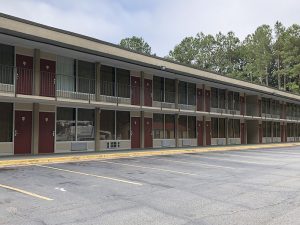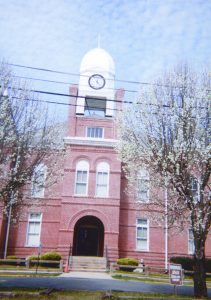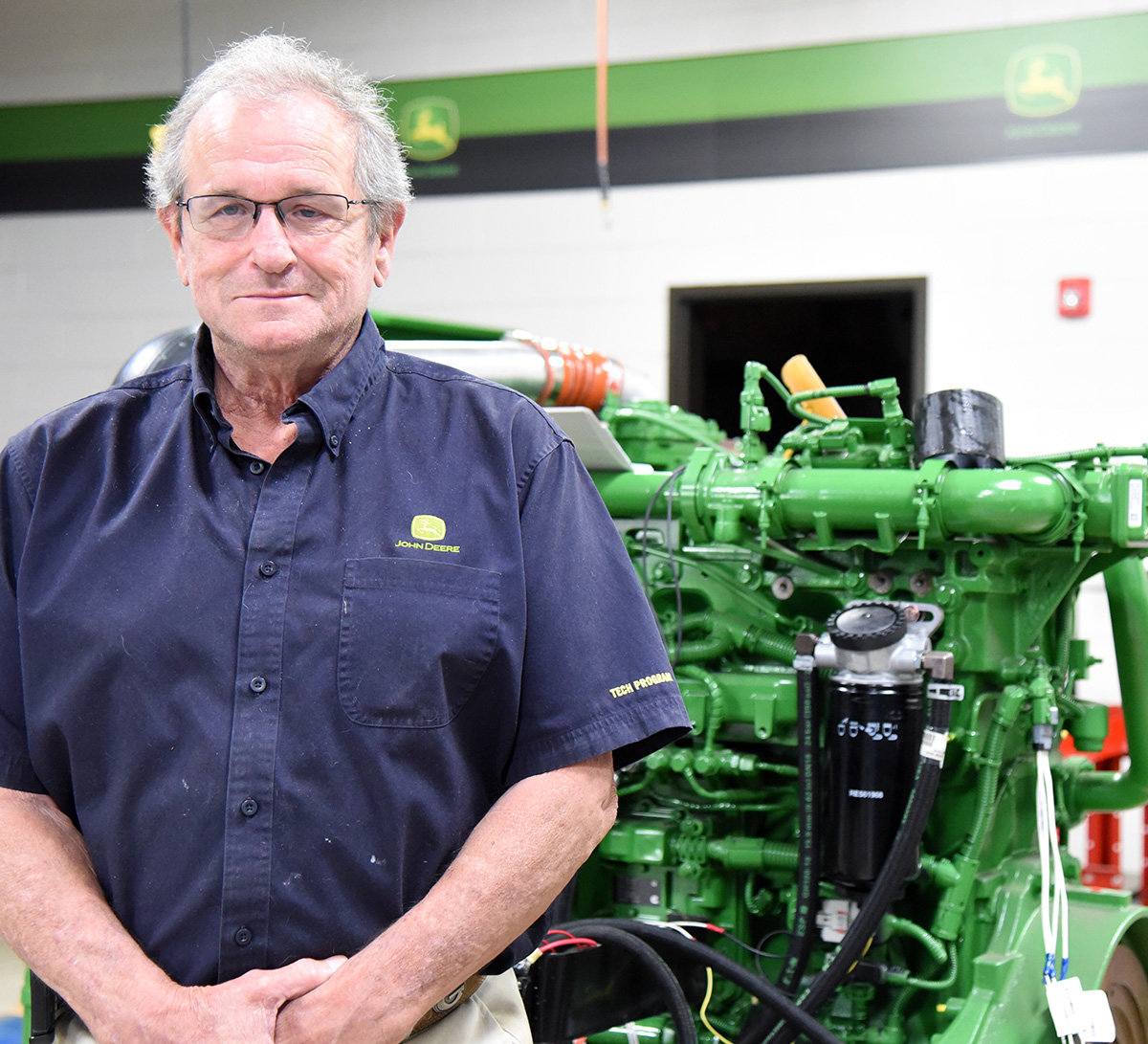End of innocence: The unsolved murder of Leigh Bell, 40 years later
Published 6:05 pm Tuesday, June 18, 2019
Part 3: Dr. Wiggins, a fire, and the trial begins
By Beth Alston
NOTE: The information contained in this five-part series is taken from the murder case file and interviews with key individuals, and media reports. Those interviewed include law enforcement and other first responders, a local journalist, and friends and family of Leigh Bell. The case was officially closed on Feb. 15, 2019, by Lewis Lamb, Southwestern Judicial Circuit District Attorney, following the death of the last suspect. Leigh Bell, a 15-year-old cheerleader, and daughter of the Americus city manager Leland Bell, disappeared on the evening of June 6, 1979.
AMERICUS — George Gignilliat was arrested on Nov. 11, 1979 in Warner Robins, charged with the murder and rape of Leigh Bell. He was taken to the Houston County Jail while the apartment where he had been located was searched. He was then brought back to Sumter County and jailed, where he would remain until his trial began in January 1980. He had been read his rights and on the drive back to Americus, and Gignilliat was questioned by Baker. Gignilliat said he got the softball field between 7 and 7:30 p.m. June 6 and did not leave until the last ballgame was over, between 10:15 and 10:30 p.m. He said he might have left the ballfield shortly after he arrived to go get some beer but returned directly back to the ballfield. He said he sat with Mr. and Mrs. (James) Farr during the entire time of all three games. After that he went to Sydney Green Elephant and then to a party. Then he dropped Derek (Henderson) and Rat (Bishop) off and picked up chicken at Church’s and then to Debra’s apartment.
After Gignilliat’s arrest, others were interviewed as the investigation continued. Current Sumter County Sheriff Pete Smith, interviewed for this series, said some 40 individuals were interviewed as suspects, “but the prime suspect was George Gignilliat.”
Trending
Debra Slaughter, Gignilliat’s girlfriend, had been questioned several times. She had given permission to have her car, which Gignilliat had admitted driving the night of June 6, searched by authorities.

The Quality Inn, located on South Martin Luther King Jr. Boulevard, was the Best Western Motel in 1979, and was where prime suspect George Gignilliat’s girlfriend Debra Slaughter was interviewed for five days by Dr. Stewart Wiggins a clinical psychologist brought in the GBI.
Dr. Wiggins
When Dr. Stewart Wiggins got to town, he interviewed several people, some under hynopsis. Wiggins, a clinical psychologist who taught at the Medical College of Georgia, was brought in by the Georgia Bureau of Investigation.
Debra Slaughter was 21. She had testified during the committal hearing that Gignilliat had told her one night that he had drugged and raped Leigh Bell, shot her, and threw her in the water. She said he was angry and said it in a sarcastic manner. She said she didn’t believe what he said.
When cross-examined by Tarver during that hearing, she said she was put under protective custody prior to Gignilliat’s arrest, at the Best Western Motel (now Quality Inn) from Tuesday to Saturday, five days. She said she was constantly questioned by Wiggins during this period. She said she was not under hypnosis to her knowledge. The way it happened, she said, was she went to the station to talk with Sheriff Randy Howard and GBI Special Agent Jim Baker about the case because she didn’t think it was being “ran right.” She said Wiggins had already questioned her the Saturday before. She said Wiggins said he was tired of the place and asked her to go somewhere and have a beer and he would brief her. They discussed it in the motel lounge, she said, and then later in Wiggins’ motel room. She said Wiggins played a Barbra Streisand tape and she spent the night with him, four nights total. She said she never had sex with Wiggins but he did make a pass at her one night. She said Wiggins told her that George didn’t love her anymore and that he (Wiggins) was capable of loving her.
Sumter County Sheriff’s Lt. Chuck Hanks, a retired law enforcement officer, was interviewed for this series. He told the Times-Recorder that he picked Wiggins up at Souther Field Airport (now Jimmy Carter Regional), when he flew in, describing him as a very distinguished looking gentleman wearing a three-piece suit and carrying a briefcase in one hand and an overnight bag in the other. Hanks’ opinion of Wiggins would change drastically very shortly.
Wiggins’ statements from his interviews with Slaughter, are in the case file. He asks Slaughter at times if he’s talking to Debra 1 or Debra 2. This is never fully explained in his statements.
One empty cylinder
Hanks told the Times-Recorder that a week after had picked up the doctor at the airport, he received a call from the sheriff, requesting that he come in that day, a Sunday and the last day of Hanks’ vacation, to drive Wiggins back to Augusta. In the late ‘70s, Hanks said, they were short-handed at the sheriff’s office with only five deputies. He said it was common practice for a deputy’s wife to ride with him on transports, especially when female inmates were transported. On this day, Hanks’ wife agreed to ride with her husband to Augusta and back, but she wanted to shower and get dressed first. Hanks said he left his wife at their home and headed toward the sheriff’s office, which was located behind the Sumter County Courthouse at the time.
“I parked my car, got out and walked into the sheriff’s office. And there is Randy Howard and Jim Baker (GBI special agent) on either side of Dr. Wiggins. Now Dr. Wiggins, this distinguished looking gentleman, had cut his suit pants off and made shorts out of them. His shirt is a white, v-neck undershirt. He’s got on his weejuns, his calf-high black socks and it’s quite a sight. His hair is just all over; looked like he had been in a windstorm. And he’s clutching his briefcase up under his arm like a football,” Hanks told the Times-Recorder.
Hanks said the sheriff, in those days, was a practical joker. “When I first walk in, I don’t know this doctor,” Hanks said. “I picked him up at the airport and dropped him off at the sheriff’s office but he looks quite different. The first thing I thought was that it was a joke. I’m looking at this guy and not only does he look way out of character from what my first impression of him, he’s got a pistol. You can see the butt of this pistol hanging out of his pocket.”
Hanks says the sheriff told him, “OK, ya’ll, let’s get going.” Hanks told the sheriff, “Wait a minute. What in the world’s going on?” and the sheriff tells Hanks he doesn’t have time to explain. The sheriff tells Hanks to take the doctor to his home, in Augusta.
“And I say, out loud,” Hanks told the Times-Recorder, “in front of Randy and Jim Baker, ‘but he’s got a gun,’ and I’m very concerned.” He said both Howard and Baker were aware that Wiggins was in possession of a gun.
At that point, Hanks addresses the sheriff. “I say to Randy, ‘you and I need to talk.’ Having this guy in my car with this gun is against everything I’ve been trained. There’s something wrong here. My intuition is that there’s a problem here, and this guy doesn’t need to be having a gun. So, I tell Randy, ‘what the hell is going on? He’s got a gun.’ He looks like crazy person. I’m not going to put him in my car with that gun? He’s supposed to be on our side. My idea is to cuff him up and put him in the backseat … Randy says ‘yes, he has gun but he’s doesn’t have any bullets. I promise you he has no bullets in that gun.’ ”
As Hanks escorted Wiggins to the patrol car, he asked if is he wanted to put his briefcase in the backseat. “Because he had hold of that thing like it was the most dear thing to him ever,” Hanks said. “He gets really loud and anxious and says ‘No! No!’ I said, ‘OK, keep it.’”
So, they both get into the front seat of the patrol car. “I have always, always worn a seat belt. But for some reason, I got in that car and I didn’t put my seat belt on,” Hanks said. He doesn’t recall Wiggins wearing a seat belt either.
“He’s [Wiggins] very anxious and nervous and he’s looking around,” Hanks said. “He’s mumbling to himself and I pull out of the parking lot and make that left-hand turn. As soon as you get into Spring Street, you’re now approaching what was the DA’s Office … ”
Hanks described Wiggins as small in stature, a little over 5 ft. tall or so, very thin. “That’s how this doctor looked. Very short, very thin. A very small person,” he said.
“I pulled out onto Spring Street … and am aware from my peripheral vision that the doctor is moving around and I look over at him,” Hanks said. “Now he has slid up against the door. He’s between the door and dash in that corner, and he’s facing directly at me. He’s holding that gun close to his chest but it’s pointed at me. It’s a revolver. When a revolver is pointed at you, you can see if there are bullets in it, in the cylinder, because it’s open. So that’s the first thing I notice. He has the gun and the gun is loaded. So, we’re rolling towards that yield sign.
“And obviously, we’re still in sight of that window where Jim Baker and Randy Howard are watching us leave. The first thought I had was ‘I’ll just grab the gun and deflect it away.’ This is entering my mind. I can grab the gun and deflect it away or I can open the door and bail out. My first thought is I can grab the gun. It’s close enough. All I have to do is lean forward and grab it. While I’m thinking this, he pulls the hammer back on the gun. If you know anything about revolvers, once you pull that hammer back, you can almost breathe on it and it will go off. So now my thoughts have changed. ‘Surely this guy won’t shoot me in the back,’ and I’m gonna bail. All this happens within a couple of seconds. I open the car door. My left foot hits the asphalt and when it does, he drops the hammer on the only empty chamber in that revolver.
“I’m going to tell you and I’ve told other people. I had never before and have never since been that afraid in my life. My life did not flash before me but I was scared. … ” While Hanks said he heard the click, he said, “The good news was it didn’t go bang. But the bad news was I knew he had more bullets.” He recalled it was a six-shot revolver, Smith & Wesson, what he described as a very popular police gun at the time.
The car was still motion, although very slowly, Hanks recalled. After Wiggins dropped the hammer, Hanks was outside the vehicle, on his knees on the asphalt, trying to get to the back of the car so he would no longer a target.
“… When my knees hit the ground, he [Wiggins] obviously threw it (the car) up into park because the car is rocking. I worked my way towards the back of the car. Randy and Jim Baker show up out of nowhere. Obviously they were watching this from the (office) window.
I have my pistol in my hand at this point, and I look in through the side glass on the passenger’s side, and he’s [Wiggins] got both hands on the steering wheel. … but I can’t see the gun. I open the passenger door and at that point I had re-holstered my weapon. And I am trying to pry his hands off of that steering wheel. I grabbed him. The gun was in the floorboard. … Obviously at some point he had thrown the gun in the floorboard. ….” Hanks said Wiggins was still in the passenger seat as he wrapped his hands around the steering wheel. Howard and Baker moved Hanks out of the way and took control of Wiggins.
“There were five rounds (in the revolver),” Hanks told the Times-Recorder. “So obviously I was upset about this. I’m almost killed. We get inside and I go off on Randy about I was almost killed. I blamed myself. It was Randy’s fault but it was also my fault because I knew better.”
The night before
Hanks said the sheriff explained to him that the night before, they had gone to Best Western Motel. Hanks said he had not known about any of this until then. Hanks said the sheriff explained to him that after Wiggins and Slaughter were sequestered in the motel room for five days, “Randy and Jim Baker go up to the room and ‘coaxed, as Randy put it to me,’ the good doctor out and then … called a deputy to check to see if she [Slaughter] was OK. He escorted her from the room and drove her home. … After they (Howard, Baker and Wiggins) had walked into the dining room. … the restaurant was closed but they were allowed in and had coffee or tea or something. The whole thing was a ruse created by Howard and Baker to get Slaughter out of that room. Wiggins wasn’t willing to let her go because he wasn’t through interviewing her yet and they insisted that she leave and he insisted that she stay. … While they’re having coffee or tea, the doctor is hallucinating, telling them that these folks are out to get him and pulls out a gun and waves it around inside the restaurant. They subdued him. Randy unloaded Wiggins’ gun and gave it back to Wiggins because he was having such a fit over not having the gun. They then escort Wiggins back to his motel room and put a deputy in the parking lot to monitor the room. … Obviously they didn’t search his room for more bullets. Thank God he had only five rounds.”
After Wiggins pulled the gun on Hanks the next morning, they took Wiggins back inside the sheriff’s office. At some point Wiggins was transported by another deputy to the (local hospital) where he was interviewed outside by a doctor who signed the commitment papers and they took him to West Central Hospital.
Randy Howard told the Times-Recorder for this series, that sometime later one of Wiggins’ doctor friends from Augusta checked him out, took him home, and Wiggins committed suicide.
“Chuck [Hanks[ was assigned to that idiot [Wiggins],” Americus Detective Lr. JamesTondee told the Times-Recorder for this series.
Tondee was asked why Wiggins even had a gun and he said Wiggins had one for “self-protection,” and that was Jim Baker’s, Randy Howard’s and Frank Myers’ idea for him to have a weapon.
The burning bed
Bobby Duke was an EMT who transported Bell’s body from the creek to the hospital morgue, But he also worked for the Americus Fire Department in 1979. At 3:30 a.m. on Aug. 28, firefighters responded to 710 Pine Ave. to a report of a structure fire. The house was the residence of Greg Farr.
Duke said he was the first on site and in charge of the fire investigation, and there was “a lot of heavy smoke and fire coming out of the back of the roof area.” He said once firefighters got inside the house and extinguished the fire in the bedroom, he thought there was also a fire in the kitchen. He said he kept putting water on the stove and he could see a light on the stove through the smoke, indicating that the stove was on. There was a pan of grease on the stove.
He recalled that once they cleared the smoke out, they found that the fire on a bed in the bedroom had burned a hole all the way through the ceiling and out the roof. “To have two fires in one house at 3:30 in the morning, there’s something definitely suspicious,” he said. Duke said told the Times-Recorder that Greg Farr showed up at the scene around 5 to 5:30 a.m.
When Duke filed his fire report, he put the cause as “unknown,” because “I couldn’t prove it [arson].” He said that, at that time, he “didn’t put all this together — Greg Farr to George Gignilliat — but after I found out whose house it was, it made sense that if they’d had that girl, they would have burned the bedroom up, because it would have destroyed all the evidence right there.”
Duke said he was upset that the fire was never investigated further. The fire chief at the time was Robert Ranew. Duke said Ranew and the fire marshal, Billy Jackson of Albany, went to the house the following day and came back saying there was no evidence of arson. There was nothing further Duke could do because Ranew was his boss. Duke said Ranew was a friend of James Farr, Greg Farr’s father, and they used to live on the same street.
The fire marshal’s report states the address of the fire as 707 Pine Ave. The narrative states, “This fire loss in question was a dwelling that was burned extensively. The remains were examined and it was determined a fire originated in a bedroom on the N.E. part of the dwelling. It appeared the fire started on a bed in the room. Also, a burner on the stove in the kitchen was on with a pan on it. A towel was lying across two burners on the stove. Could not smell any odors of volatile accelerants in the remains of the bedroom. A car was supposedly heard leaving the dwelling a few minutes before the fire was discovered.”
The trial

The Macon County Courthouse in Oglethorpe was the scene of the trial if George Gignilliat for the June 1979 rape and murder of 15-year-old Leigh Bell.
The trial began Jan. 29 and ended Feb. 1, 1980, at the Oglethorpe Courthouse in Macon County. Security was tight for the trial, according to archived stories in the ATR. Superior Court William F. Blanks, who lived in Macon County, presided. He announced earlier on that spectators would be expected to remain quiet throughout the proceedings.
Bobby Duke, the EMT and firefighter at the time, recalled that when Gignilliat was brought into the courtroom he was smiling and laughing and greeting people he knew in the gallery. Duke said he testified about transporting the body from the creek to the hospital, and then was dismissed.
The state called Sheriff Randy Howard as its first witness. He testified to the events of the night Leigh Bell went missing and the following morning.
Other witnesses for the state were Syndey Conley, a close friend of Bell’s; and Meredith Reese who testified that she helped Bell push her out-of-gas car over to the curb near the intersection of Harrold Avenue and Glessner Street on June 6.
Patricia Hall, who had been with her husband and children at a ballgame on June 6 but left because it started to rain shortly after 9 p.m., testified that as they were driving up Glessner toward Lee Street, they encountered a green Camaro driving in the middle of the street. Hall said her husband, who was driving, had to pull over to the far right and come to an almost stop as the Camaro went by. Hall also told the court that they had seen Leigh Bell walking on Glessner toward Oak Avenue, although she didn’t recognize the young girl until she saw her photo in the next day’s Times-Recorder. The husband, Joel Hall also testified that the driver of the Camaro had a beard.
Brian Mathis testified for the state that he was among many who searched for Leigh Bell after she was reported missing. He said that on June 8, he, Farron Sanders and Tommy Holman went underneath the Muckalee Creek bridge on Twin Bridges Road and found some footprints and pair of women’s or girl’s panties. They retreated and notified authorities.
Next up for the state was Van Peavy, the tracker who came from Dooly County at the request of the sheriff who would bring his bloodhound to the bridge and locate Bell’s body in the creek. The state next called GBI Special Agent Jim Baker who also testified to the chain of events from the time the body was recovered and taken to the local hospital. He was also present at the autopsy.
Dr. Charles Sheffield, on staff at the Americus-Sumter County Hospital, testified that he had treated George Gignilliat’s infected foot in the ER shortly after 3 p.m. on June 8. He also gave testimony about pronouncing Leigh Bell dead at 3:56 p.m. June 8 in the hospital morgue.
Lt. James Tondee, detective with the Americus Police Department, was the state’s 11th witness. Tondee, now retired, testified to being at the creek when the body was discovered, escorting the ambulance containing Bell’s body to the hospital morgue, and being present during the autopsy. He also told the court that while standing outside the morgue door, he saw Gignilliat walk down the hall from the ER, took a couple of steps toward him, stopped, repeated his steps, and then turned and walked away, without ever speaking.
Upon cross-examination by defense attorney L. Lyn O’Berry, Tondee was asked if he was aware of the sheriff’s office having been involved in “some problems involving the jail during early 1979 into the summer.”
Special prosecutor J. Frank Myers asked the court for a hearing on the matter outside the presence of the jury. “ … if we are going into something that happened prior to this case. I object to going into it. If the court doesn’t want to sustain it, I want to be heard.”
O’Berry withdrew the question, advising the court that he would ask about it when the sheriff or Baker was on the stand.
Leigh Bell’s aunt Bonnie Morgan was called to the stand. She testified that she was at the Bell home the day after her niece had disappeared, and that Gignilliat had come to the house. Morgan said she was sitting under the carport when Gignilliat asked about Leigh Bell, saying he had not seen her and was unaware she was missing until early that morning when the sheriff visited him at his girlfriend’s apartment. Morgan told the court that Gignilliat sat next to her. She said they were facing the side of the carport and Catherine Bell, Leigh’s mother, was sitting facing the street. Morgan said she thought Gignilliat said he had not seen Leigh Bell since Monday.
Read Part 4 in the Wednesday, June 26 edition of the Times-Recorder. Read more trial testimony including some explosive moments in open court, and read about what authorities found out during the “second investigation,” which began in 2000, when a confidential informant steps forward, and leads GBI investigators to new evidence in the Leigh Bell murder case.







